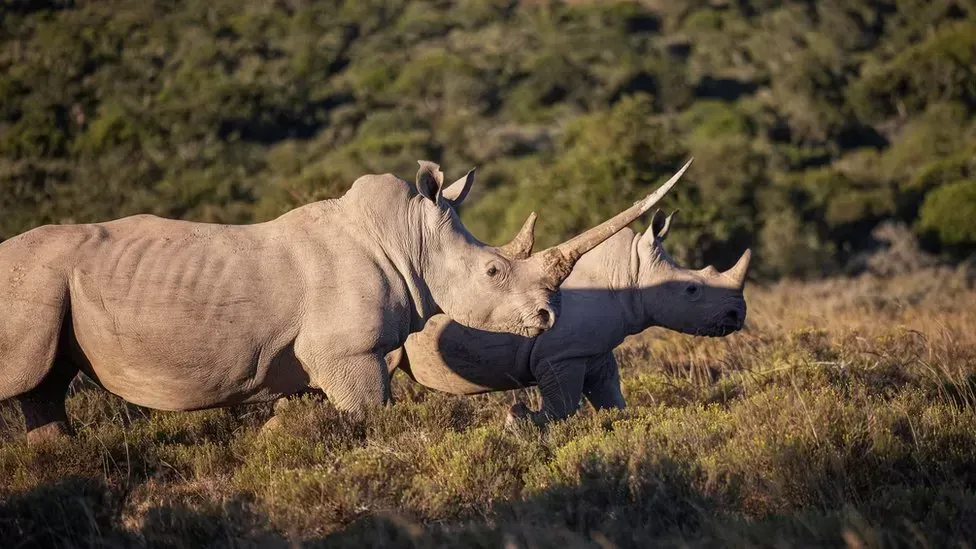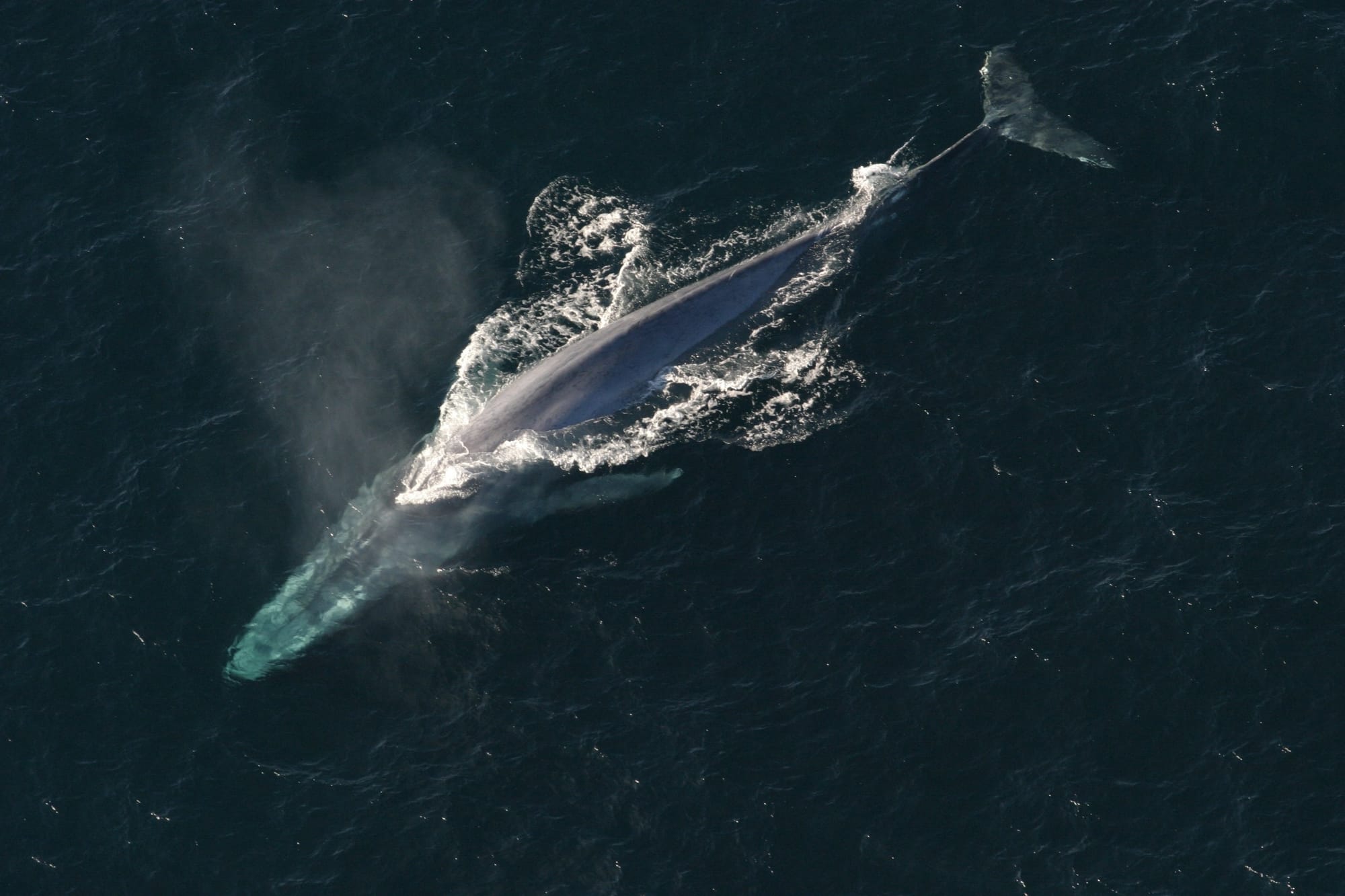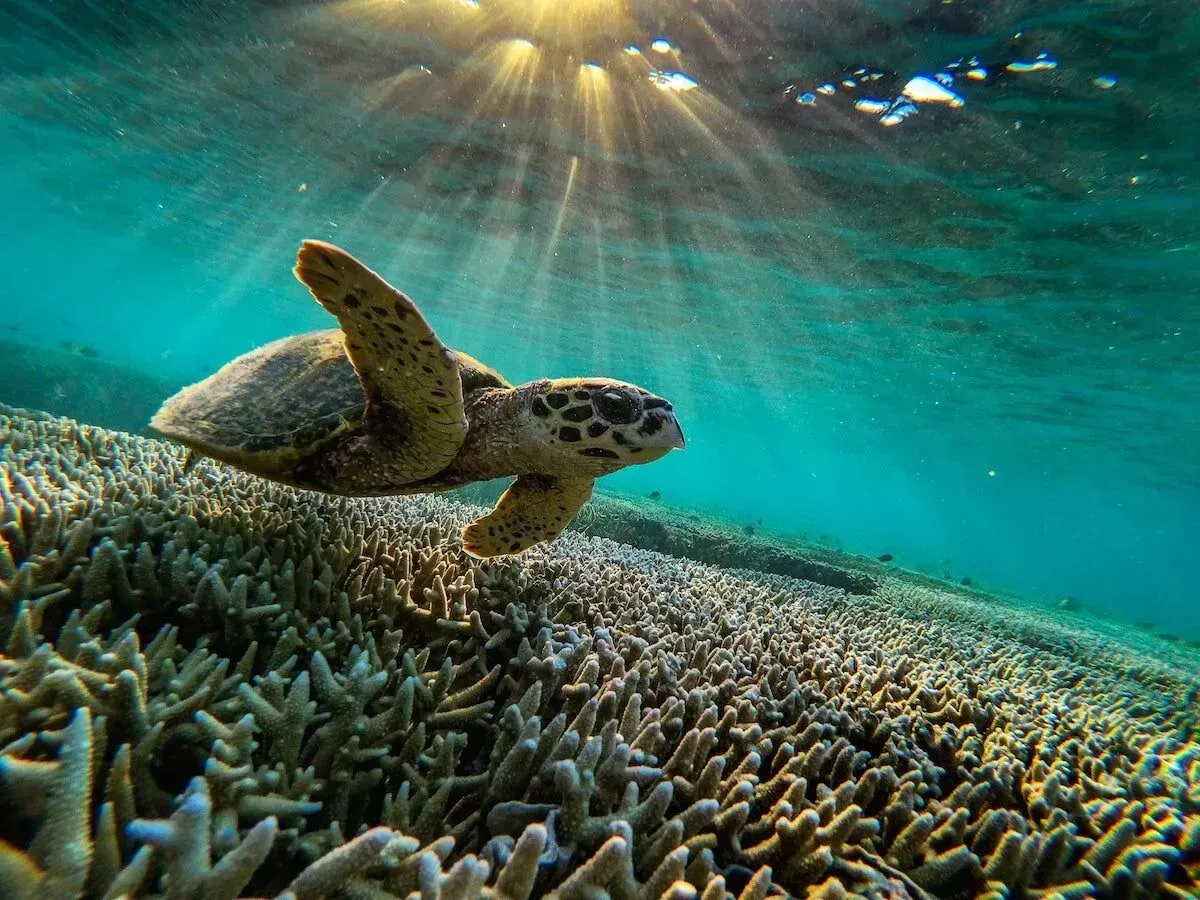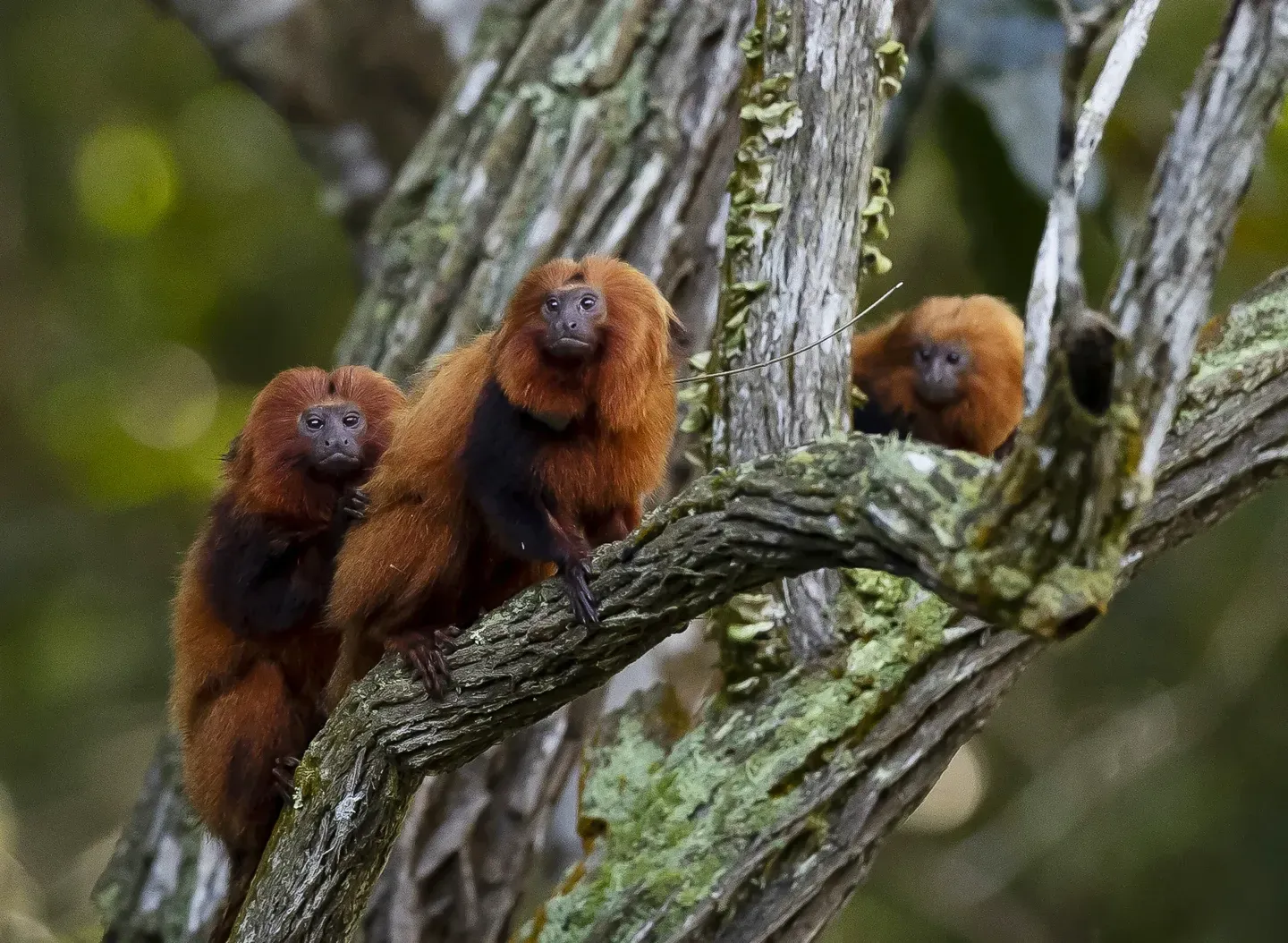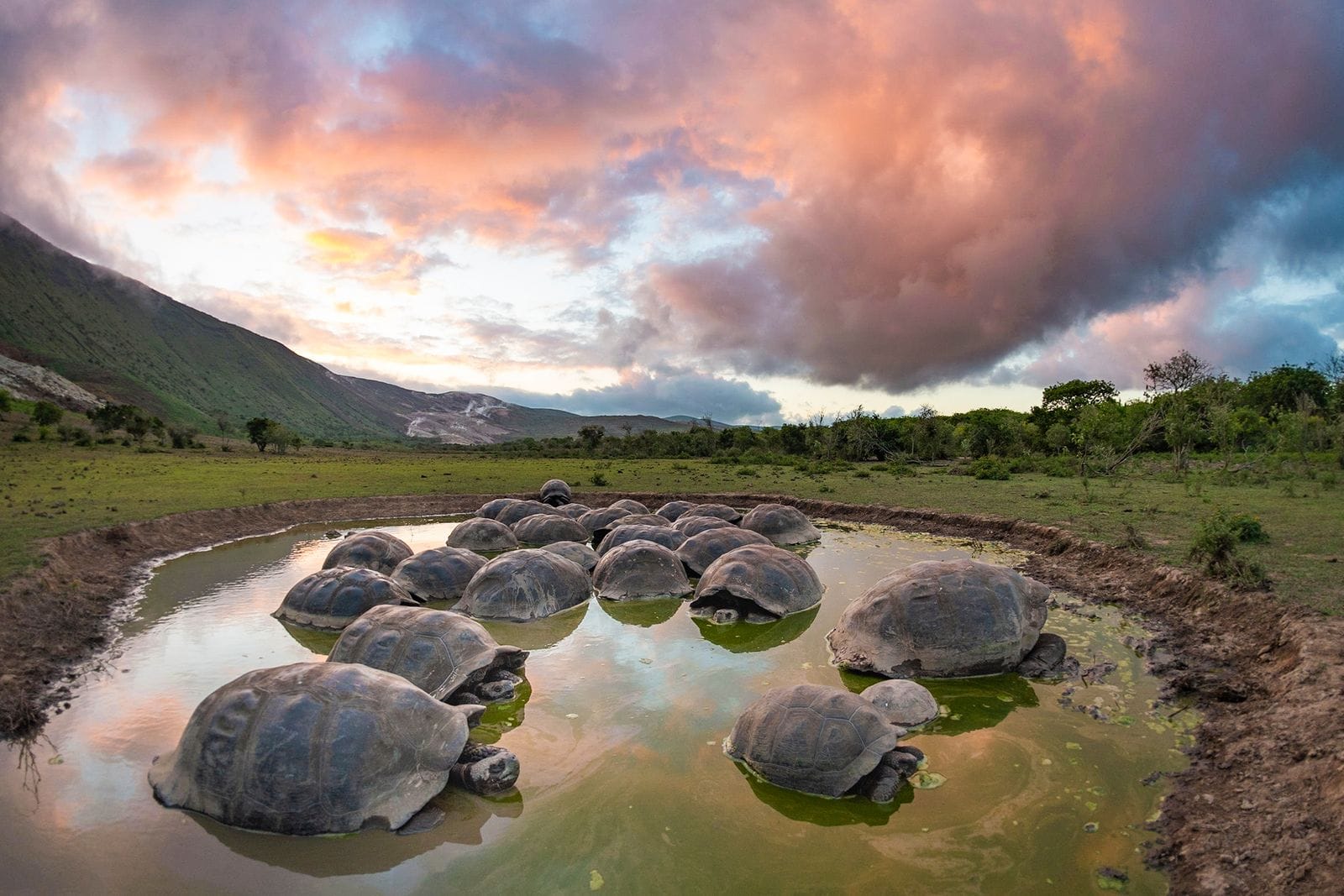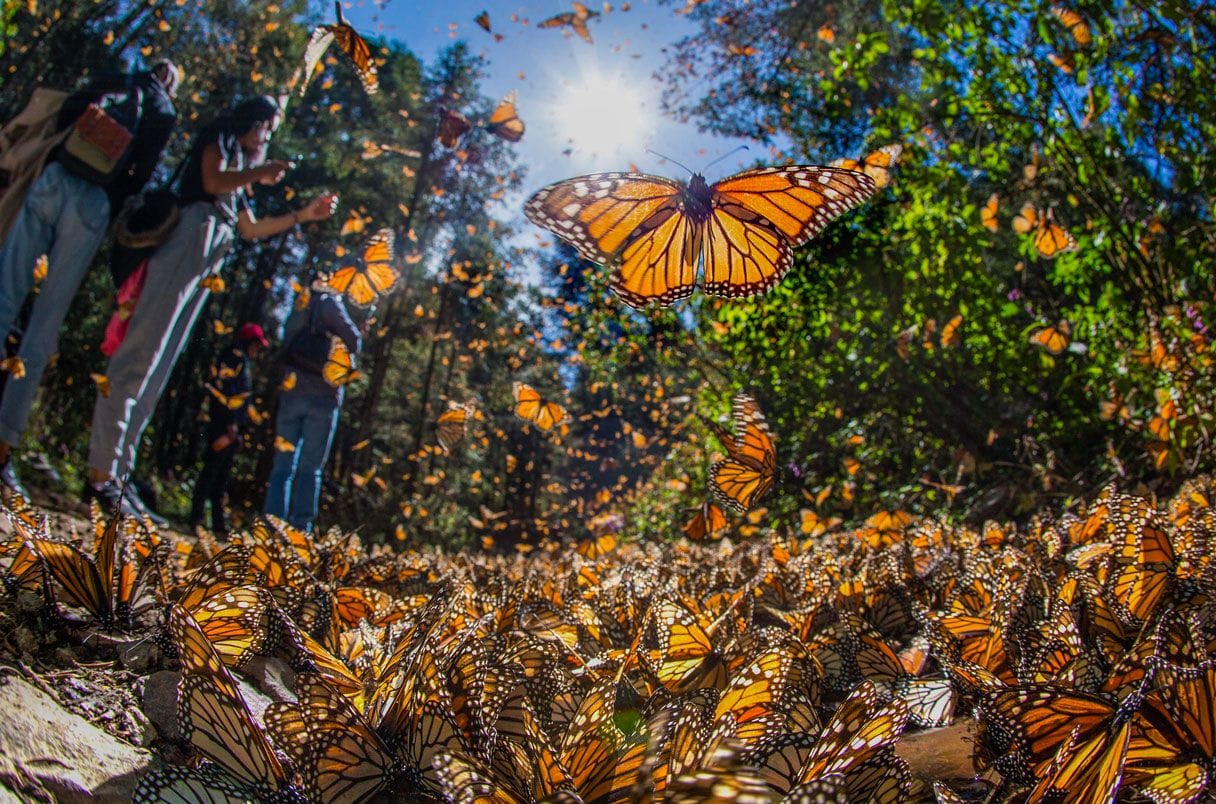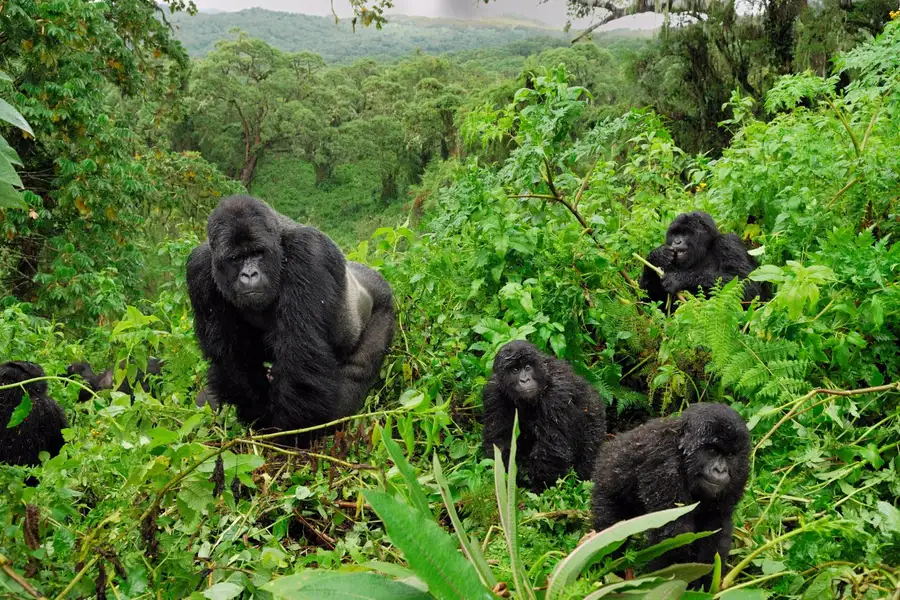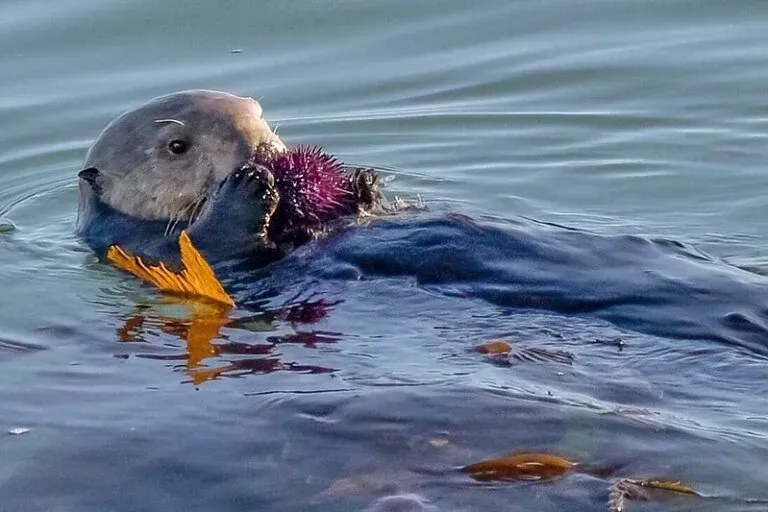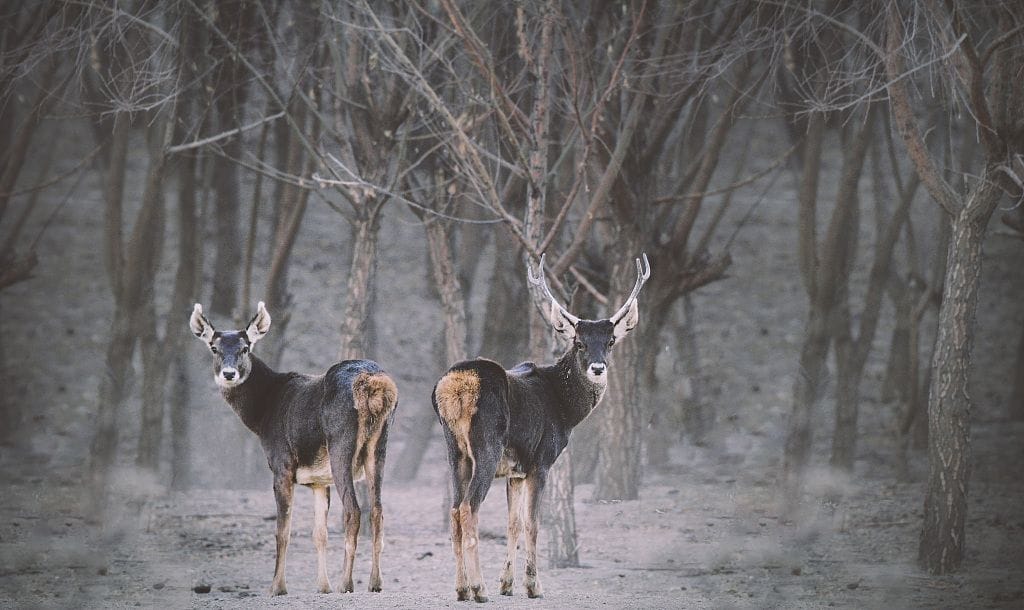We're on a mission to fix the news. To join us, subscribe for free here.
The news is supposed to tell us what's happening in the world. It doesn't. It tells us what's going wrong. Thanks to a combination of commercial pressures, cognitive biases and cultural habits, news organisations have become modern-day doom machines, showcasing the worst of humanity, without highlighting any progress, healing or restoration. Yes, journalism is supposed to hold truth to power and when terrible things happen we shouldn't turn away. But when we only hear stories of doom, we fail to see the stories of possibility. We deny ourselves the opportunity to do better.
The American journalist Krista Tippett says that we're all fluent enough by now in the language of catastrophe and dysfunction, and what's needed are more of what she calls 'generative narratives.' This year, we found over 2,000 of those kinds of stories, and shared them with tens of thousands of readers in a weekly email. Not dog-on-a-surfboard, baby-survives-a-tornado stories, but genuine, world changing stuff about how millions of lives are improving, about human rights victories, diseases being eliminated, falling emissions, how vast swathes of our planet are being protected and how entire species have been saved.
We rounded up 400 of our favourites, and then crammed all of those again into this final list of 66. We think many of them will surprise you, and a few might just change the way you think about the world. It's been a difficult year, but in so many ways and in so many places, we've made progress too.
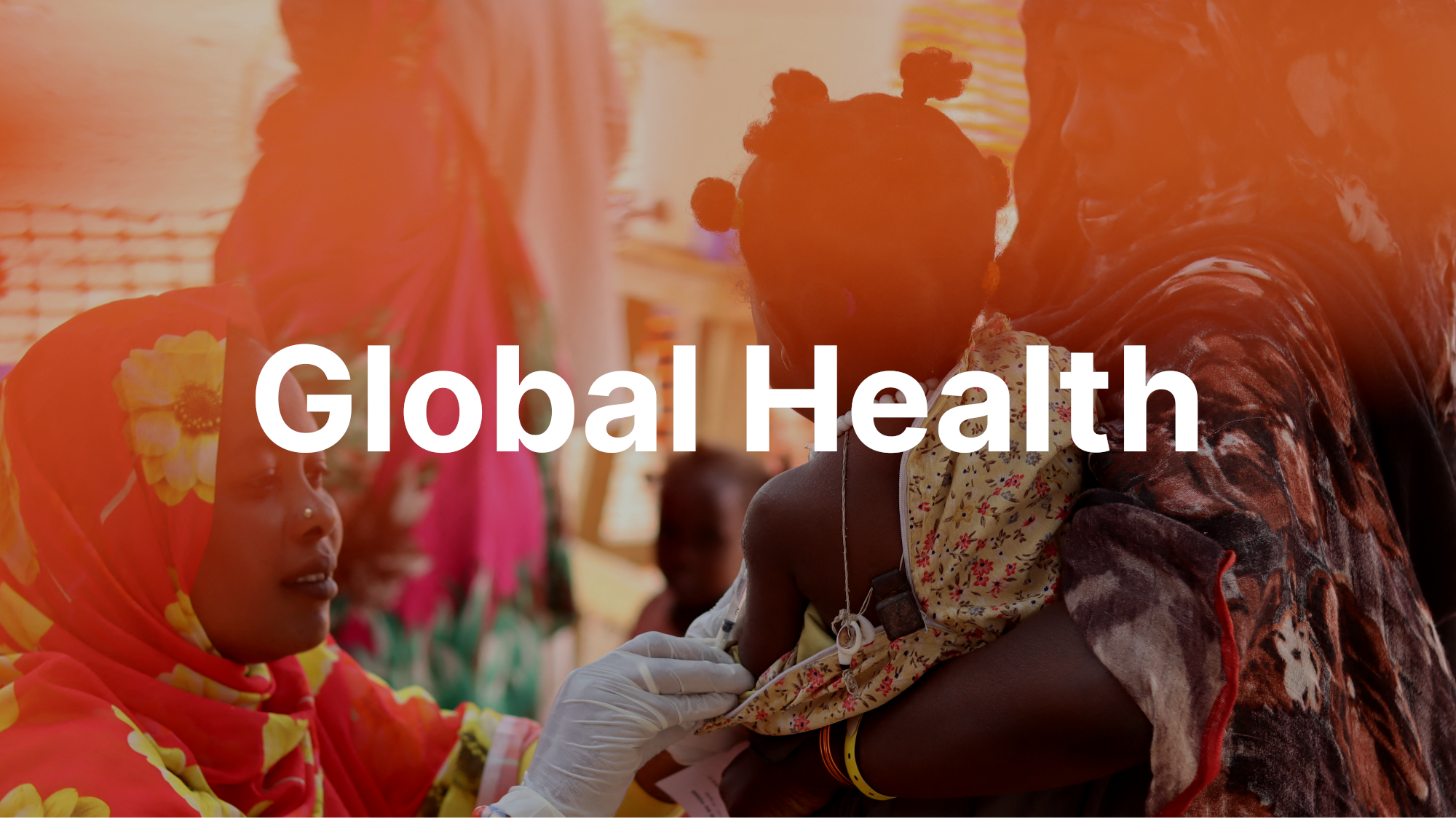
1. A record number of countries eliminated diseases this year
Egypt became the first country to eliminate hepatitis C, (which is crazy given that it used to have the highest burden in the world), the Maldives became the first country to eliminate leprosy, Bangladesh became the first country to eliminate black fever, and also eliminated elephantiasis, Niger became the first African country to eliminate river blindness, Benin, Mali and Iraq eliminated trachoma, Timor-Leste, Bhutan, and North Korea eliminated rubella, Ghana eliminated sleeping sickness, and Azerbaijan, Tajikistan and Belize eliminated malaria.
2. Progress in the fight against cancer
European cancer mortality for 2023 was estimated to be 6.5% lower for men and 3.7% lower for women than in 2018, the United States reported cancer death rates have fallen by a third in the last three decades, Australia reported significant reductions in skin cancer in under 40s, there were major breakthroughs in treatments for colon, skin, bladder and cervical cancer, and Pfizer announced it would offer all patented cancer drugs at cost to 1.2 billion people in low-income countries.
3. Malaria vaccines started arriving in Africa
A malaria vaccine is the holy grail of global health. We've been trying to create one for over 70 years, and now we are about to unleash not one but two of them against a disease that infects 247 million people and kills half a million children every year. That’s more than 1,000 deaths of children every day. The first vaccine, Mosquirix, started arriving in nine African countries this year (it reduces severe malaria by 22%, and reduces deaths from all causes by 13%) and in October, the WHO approved a second, cheaper version called R21/Matrix-M which UNICEF will start distributing to millions of kids in 2024.

4. New therapies reshaped how obesity is treated
Obesity is a public health crisis. In the United States, around 70% of adults are affected by excess weight, and in Europe it's more than half. This year however, a new class of therapies, most notably Ozempic and Wegovy, proved that not only could they induce significant weight loss, but drastically reduce symptoms of heart failure and the risk of heart attacks and strokes. Could this class of drugs actually safeguard health in people with obesity? This year brought an answer: yes.
5. Some bright spots for maternal and child health
India, Kenya, Rwanda, Uganda, Mozambique, Ethiopia, Liberia, Ghana, Malawi, Tanzania and Sierra Leone all reported significant declines in maternal and child mortality, as did the entire Southeast Asia region, in August, the WHO reported that exclusive breastfeeding has increased from 38% to 48% globally in the last decade, and UNICEF reported that eight in ten children are now welcomed into the world by a trained professional in a health facility, up from six in ten a generation ago.
6. We're winning the war on AIDS
Two decades ago, the disease seemed unstoppable, killing two million people a year, but today, it's a very different story. In July, the United Nations revealed that in 2022, deaths fell to 630,000, there were an estimated 1.3 million new infections, the lowest since the early 1990s, and only 130,000 new infections in children, the lowest since the 1980s. There's also been notable progress on the legal front, with several countries removing laws preventing access for marginalised groups in the last two years.
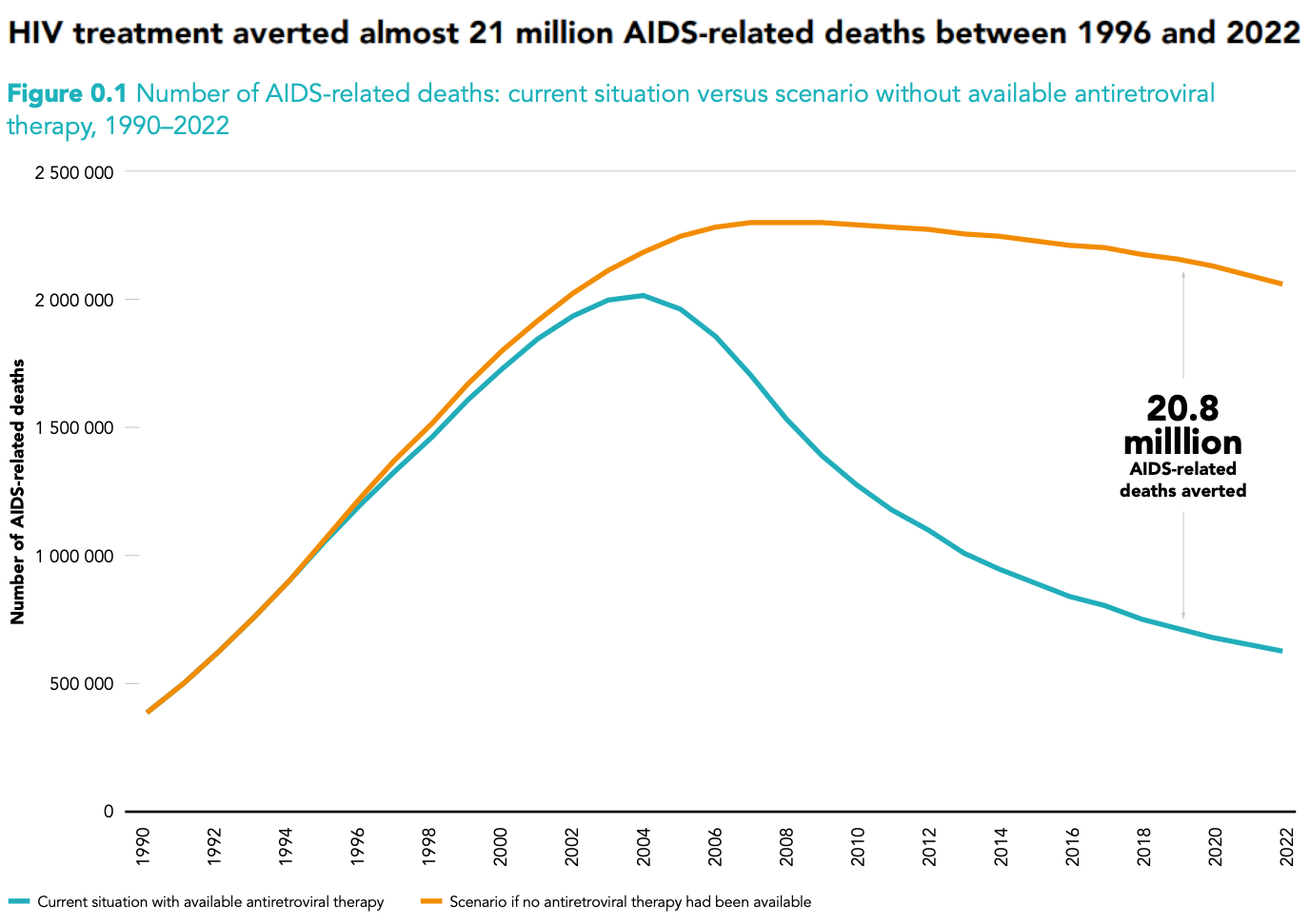
7. Uncelebrated progress on smoking
5.6 billion people are now protected by at least one policy to help reduce smoking - and without measures implemented in the last 15 years, there would be an estimated 300 million more smokers in the world today. We also learned this year that humanity has made astonishing progress on reducing drowning, with deaths declining from 531,956 to 295,210, and age-standardised mortality rates falling by 57.4% in the last three decades.
8. Childhood vaccinations got back on track
Record vaccination drives took place this year in Uzbekistan, the Philippines, Malawi, Cameroon, Madagascar, Chad, Ghana, Niger, Brazil, the Central African Republic, Guinea, Somalia, South Sudan, and the Democratic Republic of the Congo, and in July, the WHO reported that the number of zero-dose children (those missing out on any vaccinations), fell to 14.3 million in 2022, nearly back to pre-pandemic levels.
9. Polio and Guinea Worm are so close to eradication
Polio is now restricted to just seven districts in Pakistan and two provinces in Afghanistan, the Taliban has reversed course and decided that elimination is now a priority, and in December, world leaders committed $59 million for 'last mile' efforts, with a view to complete elimination by 2026. Meanwhile, only six cases of Guinea Worm were reported worldwide in the first ten months of this year, putting the goal of eradication tantalisingly close.
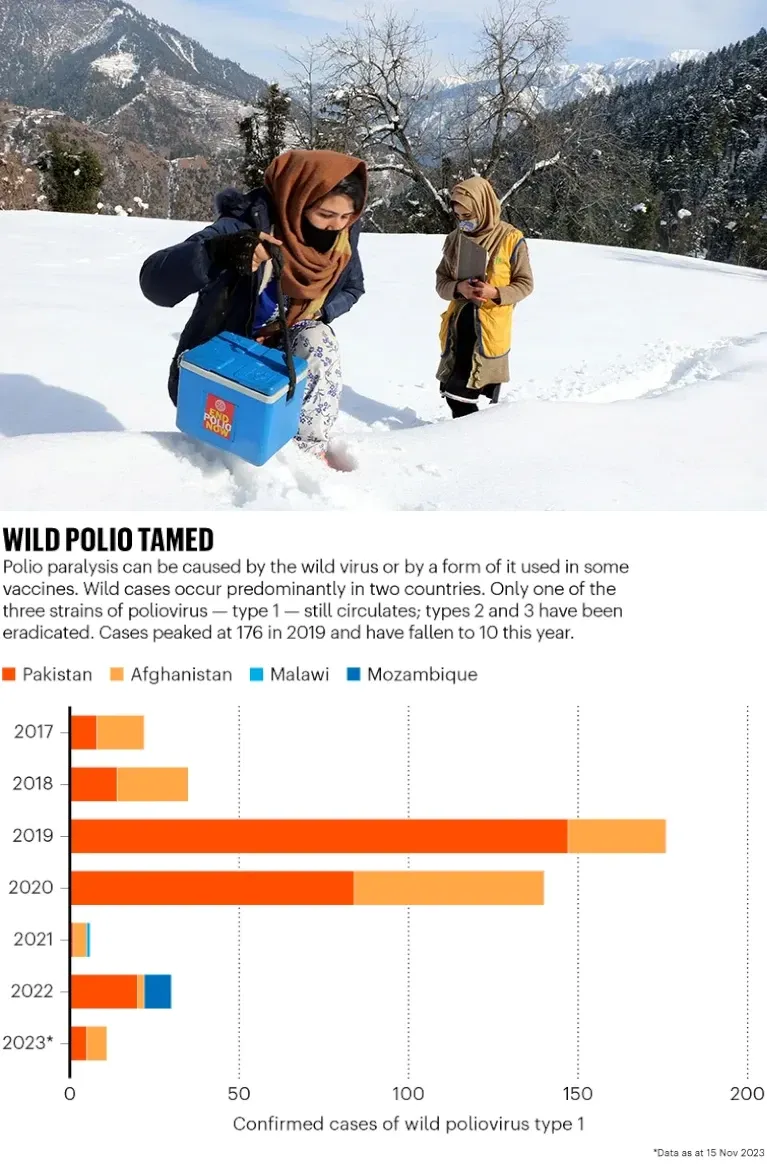
10. A recovery in the fight against tuberculosis
TB is the deadliest infectious disease in the world, but this year, one of the world's biggest pharmaceutical companies said it would allow generic versions of its life-saving TB drug to be supplied to 44 low-income countries, trials of a new vaccine covering 26,000 people kicked off in Africa and Asia, and in November, the WHO said there were over 100,000 fewer TB deaths in 2022 compared to 2021.
11. Breakthroughs on new medicines
Two powerful new drugs, Donanemab and Lecanemab, heralded a turning point in the fight against Alzheimer’s, the decades-long campaign to make insulin less expensive scored a major victory when the world's three biggest manufacturers lowered their prices, a new meningitis vaccine raised hopes for a disease that kills about 250,000 people a year, and Australia became the first country in the world to classify psychedelics as medicines, approving their use to treat some mental health conditions.
12. A turning point for cervical cancer
The world's biggest vaccine maker, the Serum Institute of India, announced a new, affordable version of the HPV vaccine this year, putting the WHO's goal of 95% coverage by 2030 within reach. In the past three years, 30 countries - including some of the largest in the world, like Bangladesh, Indonesia, and Nigeria - have introduced the HPV vaccine, and global coverage for all girls has increased to 21%, exceeding pre-pandemic levels for the first time.
13. CRISPR gene-editing came of age
When looking back on 2023, future generations might decide that this was actually the biggest health story of the year. 11 years after its discovery, CRISPR was approved by regulators for the treatment of sickle cell disease in the United Kingdom, Bahrain and the United States. The treatment will prevent episodes of excruciating pain, as well as free people with beta thalassemia of regular blood transfusions, and for some, may even be a cure. “This is just the start of CRISPR therapies. There are a lot more to come.”

14. The greatest year ever for clean energy
Thanks to the staggering uptake of wind and solar, energy researchers had to tear up all their old forecasts, including the International Energy Agency (IEA), which announced in October that global fossil fuel use may peak this year, two years earlier than predicted just 12 months ago. More than 120 countries, including the world's two largest carbon emitters, China and the United States, also agreed to aim to triple renewable energy and double energy efficiency by 2030 - a target that if met, would keep the world on track for 1.5°C.
15. Solar installations changed our climate future
Humanity will install an astonishing 413 GW of solar this year, 58% more than in 2022, which itself marked an almost 42% increase from 2021. That means the world's solar capacity has doubled in the last 18 months, and that solar is now the fastest-growing energy technology in history. In September, the IEA announced that solar photovoltaic installations are now ahead of the trajectory required to reach net zero by 2050, and that if solar maintains this kind of growth, it will become the world's dominant source of energy before the end of this decade.
16. China's carbon emissions are likely to start falling next year
This, and not COP28, was the most important climate change story of the year, because China is the world's largest carbon polluter, and was supposed to still be six years away from peak emissions. The reason for this epochal shift? The country's unprecedented buildout of 300 GW of solar and wind in 2023, almost double its 2022 total. It's the largest ever single year deployment of energy in our species' history. “There’s nothing you can benchmark this against."
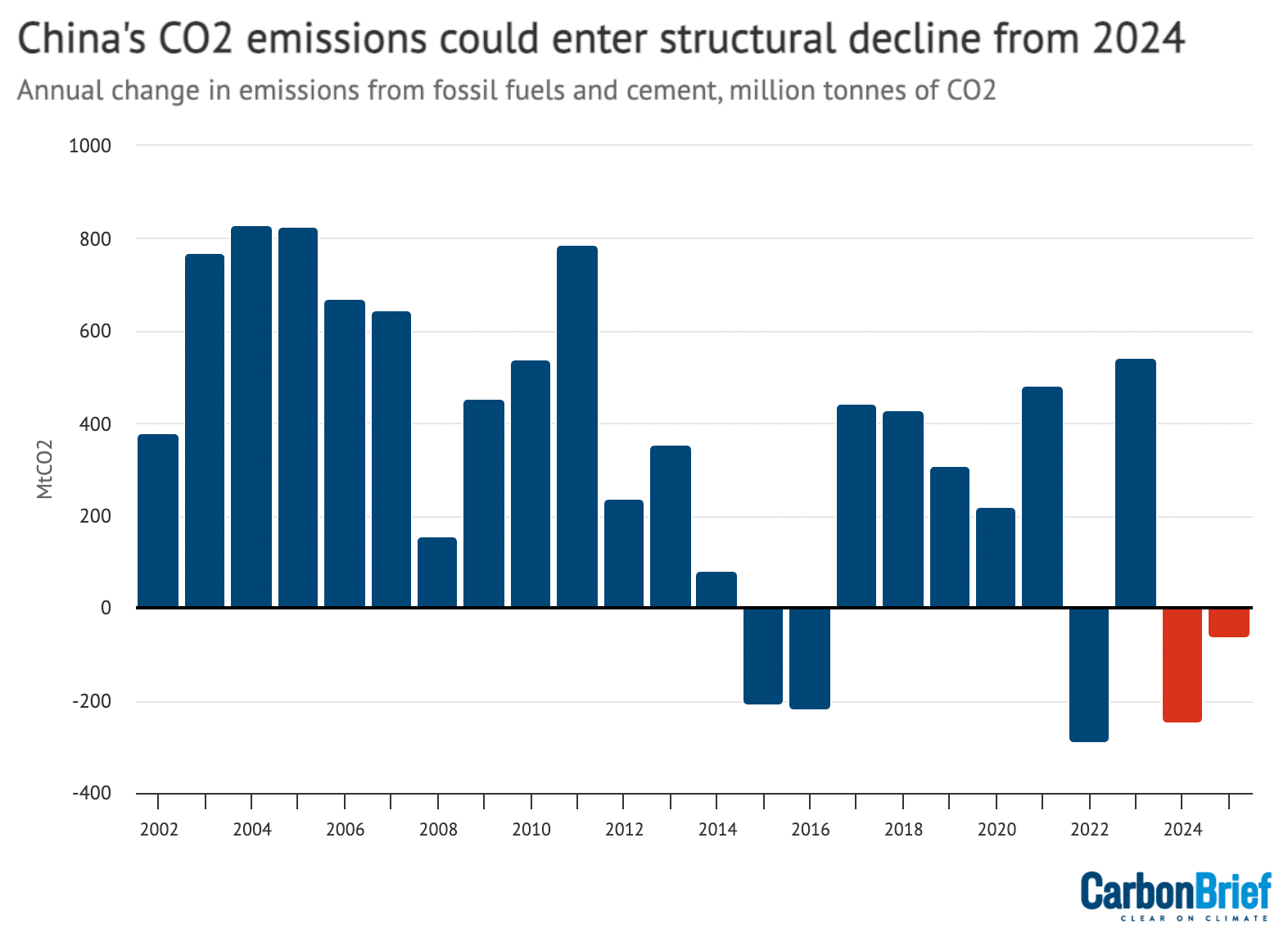
17. A green manufacturing boom in America
The Inflation Reduction Act is the single largest commitment any government has yet made to vie for leadership in the next energy economy, and has resulted in the largest manufacturing drive in the United States since WW2. The legislation has already yielded commitments of more than $300 billion in new battery, solar and hydrogen electrolyzer plants, with Georgia, Michigan, Texas, Tennessee and Kentucky in the lead. This year a record 33 GW of solar was installed across the country, carbon emissions are set to fall by around 3%, Texas is undergoing the fastest pace of clean energy expansion anywhere in the world outside China, California's battery storage capacity has surged tenfold in just three years, and 12 states have now passed laws requiring a shift to 100% clean electricity.
18. Europe knocked years off its decarbonisation timeline
Coal generation in Europe plummeted in 2023, leading to fossil fuels' share of electricity generation falling to a record low of 17% in the first half of the year, while solar installations increased by 40% for the third year in a row. The continent has also managed to kick its addiction to Russian fossil fuels, phasing out coal imports, reducing oil imports by 90% and reducing fossil gas imports from 155 billion cubic meters in 2021 to an estimated 45 billion cubic meters in 2023.
19. The clean energy revolution ramped up in many countries
Rooftop solar overtook coal as Australia's biggest source of electricity capacity, the Philippines saw explosive growth in offshore wind, South Africa's rooftop solar sector became the fastest growing in the world, Canada became the second-most attractive place in the world for renewables developers (after the United States), Brazil invested billions into grid transmission, the United Kingdom reported that carbon emissions have fallen by more than two-thirds in a decade, and Vietnam finalised its Just Transition agreement, including no new coal, which is great news for the planet, because it has the world's third largest coal pipeline.
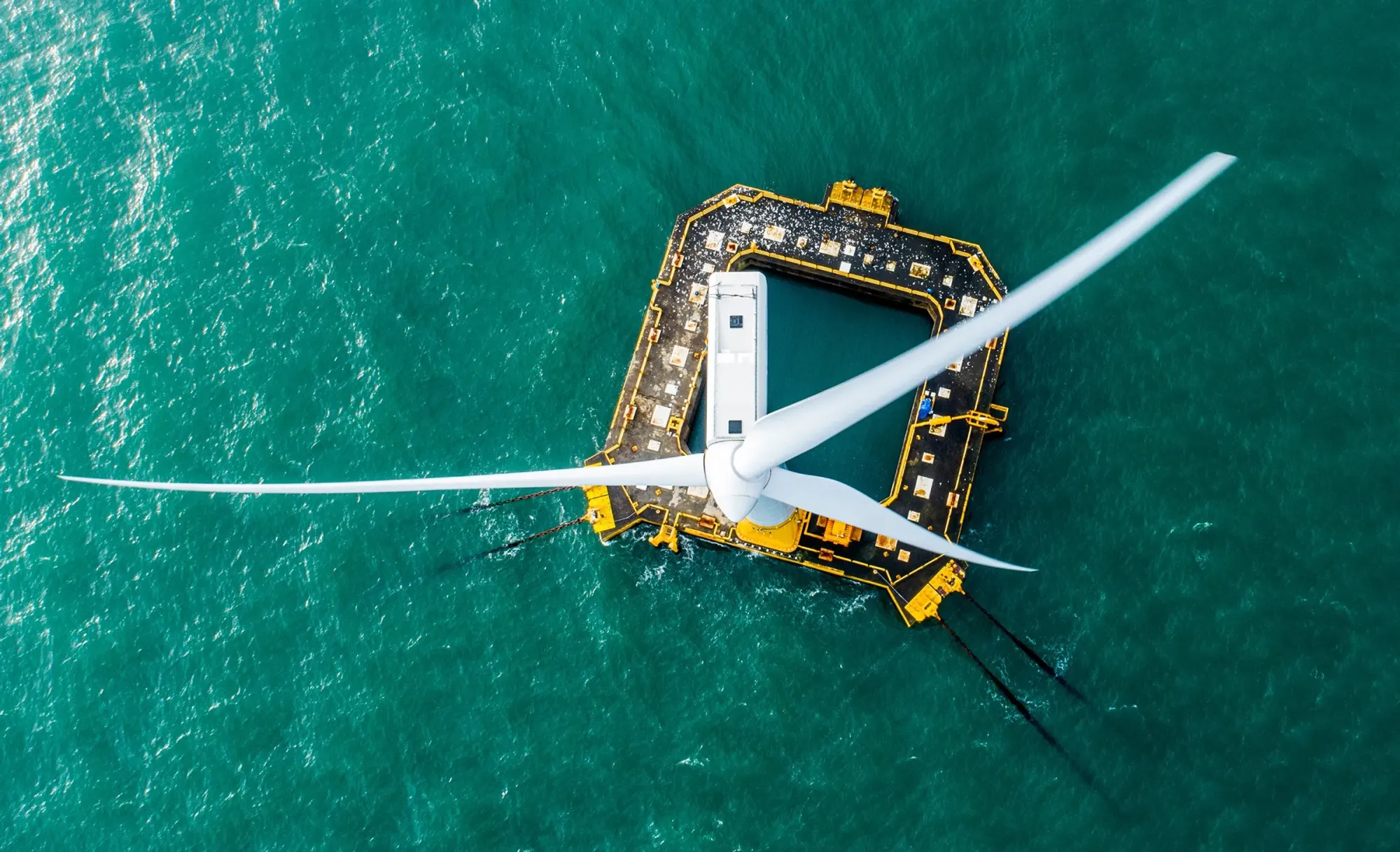
20. No signs of an electric vehicle slowdown
Global electric vehicle sales increased by 36% this year, bringing the world's total to 41 million electric vehicles. The shift is remarkable: just two years ago, one in 25 cars sold globally was an electric vehicle. This year it will be one in five, and by 2025, one in two. The IEA now says that electric vehicle sales, like solar installations, are tracking ahead of its net zero scenarios. In the United States, where the media spent much of the year insisting there's been a slowdown, sales were up 50%, and growth in China was even more explosive; two in every five new cars sold was electric, and gasoline demand peaked two years earlier than expected. Oh, and the Tesla Model Y became the best-selling car in the world in 2023.
Want more good news? Sign up for free below.
21. Battery technology made some big leaps forward
CATL, the world's biggest battery maker, announced a new battery with double the density of Tesla's batteries which it said would go into mass production imminently, Toyota, the world's largest carmaker, claimed it had developed a solid state battery with over 1,000 km of range (and then got trumped by Chinese EV maker NIO which pulled off an actual demo of 1,000 km battery) and Swedish manufacturer Northvolt announced a breakthrough in sodium batteries, an element that's cheaper, more abundant, and more sustainable than lithium.
22. We found plenty of raw materials for the transition
After years of hand-wringing about the lack of critical materials, this year saw the discovery of huge new deposits of lithium in the United States and phosphate in Norway, a plunge in lithium and cobalt prices as new mines and processing plants solved shortages sooner than expected, and multiple studies showing that the world has more than enough materials for the clean energy transition. Reaching net zero will only take one quarter of today’s lithium, one-third of nickel and a quarter of known cobalt resources. These studies led to the creation of our favourite clean energy graph of the year.

23. Geothermal had a breakout year
In April, Lazard, widely regarded as the industry standard for the average cost of energy technologies, shocked analysts with the news that geothermal, the dark horse of the clean energy revolution, was competitive with fossil gas. Everyone was even more surprised in November, when a startup announced that its next generation geothermal plant had started sending carbon-free electricity to the grid in Nevada, proving that the earth’s heat could be a commercially viable, huge source of carbon-free power.
24. America and Europe got serious about transmission
In one of the most important, and least appreciated energy stories of the year, the US government approved major reforms governing new connections to the nation’s grids, broke ground on thousands of kilometres of high voltage power lines, and made its largest transmission investment ever into 58 projects across 44 states. Regulators in Europe also got the memo - the European Commission drafted plans to scale up investment into Europe's power grids, giving special status to at least 68 projects, with access to faster permits and funding.
25. BYD became the biggest electric carmaker in the world
In April, Chinese automaker BYD put the global automotive industry on notice with the launch of its compact, fully-electric Seagull vehicle, with a starting price of $12,000. By November, the company had produced 200,000 of them, making it one of the fastest-selling vehicles of all time. This capped a standout year in which BYD overtook Tesla in sales, and then overtook Ford to become the the world's fourth largest manufacturer by volume, producing its six millionth vehicle in November, just three months after reaching five million.

26. Europe and America got serious about methane
Methane is the second-biggest cause of climate change after carbon dioxide, so it was really good news when, towards the end of the year, the EU launched a continent-wide tax on carbon in imported goods, the first time such a tax has been tried at this scale anywhere in the world, and then reached a deal on a law to place methane emissions limits on oil and gas imports starting in 2030. Even better, just before COP28, the United Stated implemented the most protective methane pollution limits in the world.
27. Finance fled from coal, gas and oil
Over three quarters of coal-fired electricity in the OECD is now on track to close by 2030, and the IEA's estimates for fossil gas deployment have halved in the last five years. Danske, the second-largest bank in the Nordic region, declared an end to fossil fuel financing, SMBC Group, Japan's second largest bank, said it will phase out all exposure to coal mining by 2040, CBA, Australia’s largest bank, ruled out finance for new oil and gas extraction, HSBC and BNP Parabis said they would no longer provide finance for metallurgical coal, Citi, the world's second-largest funder of fossil fuels, committed to cut lending to the thermal coal mining sector by 90% by 2030, and Chubb, the world's biggest property and casualty insurer, said it would no longer provide coverage for oil and gas projects without a plan to reduce methane emissions, or if they are located in any of the world’s 284,122 protected areas.
28. The outlook for shipping and steel improved
Last year saw a record 59% of new ships ordered capable of using clean fuels, this year the global shipping industry agreed to cut total annual emissions of greenhouse gases by 70% by 2040 and in October, the world's biggest shipping company, Maersk, unveiled its first container ship powered by green methanol. Meanwhile, massive investments into steel decarbonization were announced in Sweden, the United States, and Japan, 43% of planned steelmaking capacity globally is now slated to use electric-arc furnaces, and the UK, India, Canada, Germany, Japan, Saudi Arabia, Sweden, and UAE established the Industrial Deep Decarbonization Initiative which requires governments to commit to procure low-emission steel, cement and concrete.
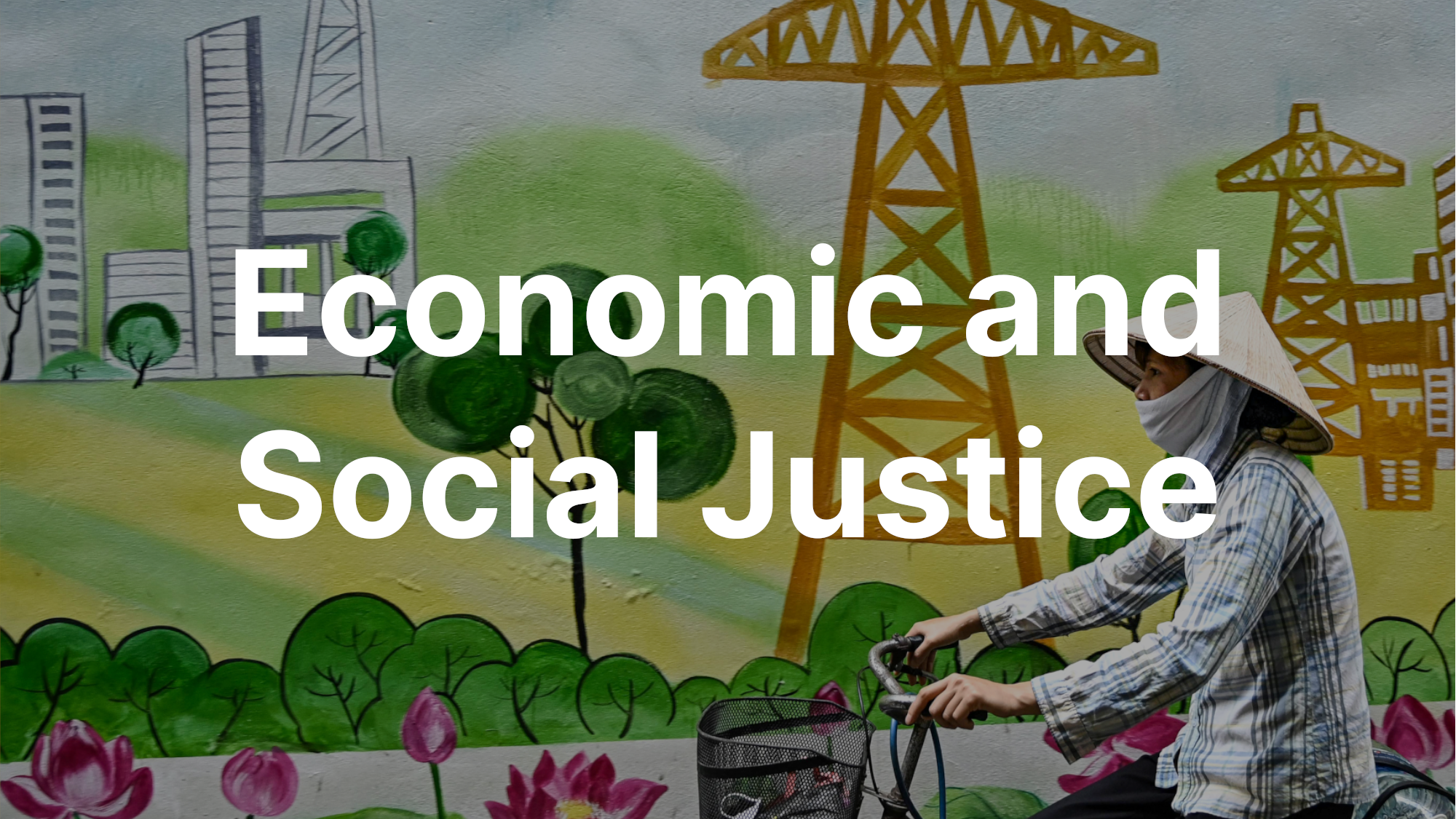
29. Global poverty reduction is back on track
After the setbacks of the pandemic, the World Bank said that a majority of low and middle income countries will see poverty decline in 2023, and more than half will reach a lower poverty rate than in 2019. The two standouts are India, which has lifted hundreds of millions of people out poverty in the last two decades, and Indonesia, which has reduced its share of people living on less than $3.20 a day from 61% in 2002 to 16% in 2022. Bangladesh also reported it has lifted almost ten million people out of poverty since 2016, Cambodia has halved its number of poor from 5.6 million to 2.8 million since 2015, the number of people living in poverty in Mexico has declined by 8.9 million since 2020, over 1.5 million people in Uganda have joined the middle class since 2017, and Togo expanded its social safety net this year to provide cash transfers to all 1.8 million of its extreme poor.
30. Suicide rates are falling
Over the past three decades, global suicide rates have fallen by more than a third, thanks primarily to rising living standards in the two most populous countries in the world. In this century, suicide rates have fallen by a third in India and by more than half in China, where one of the most common means of suicide is pesticides. Banning or limiting access to dangerous pesticides has had some astonishing effects in other countries. In 1995, Sri Lanka had the highest suicide rate in the world. That year, it banned dangerous pesticides, and the national suicide rate has since fallen by 70%. In Bangladesh, a similar ban led to a 65% reduction
31. More girls are getting an education
UNICEF reported that there are 50 million more girls in school today than there were in 2015. During this period, completion rates for girls have increased from 86% to 89% in primary school, and from 54% to 61% in high school. There are five million more girls completing all levels of education every year now compared to seven years ago.

32. More children are getting fed at school
The World Food Programme revealed that the number of children benefitting from school meals worldwide is now 418 million, 30 million more than were reached before the pandemic in early 2020. This is due to governments ramping up domestic funding in the last two years to nearly $48 billion overall for these programs, something that is happening in both rich and poor countries.
33. Crime plummeted in the United States
Initial data suggests that murder rates for 2023 are down by almost 13%, one of the largest ever annual declines, and every major category of crime except auto theft has declined too, with violent crime falling to one of the lowest rates in more than 50 years and property crime falling to its lowest level since the 1960s. Also, the country's prison population is now 25% lower than its peak in 2009, and a majority of states have reduced their prison populations by more than that, including New Jersey and New York who have reduced prison populations by more than half in the last decade.
34. The world moved closer to a fairer international tax system
In 2015, the equivalent of 9% of global GDP was held in tax havens. Today, thanks to the automatic exchange of bank information, this is down to around 3%, and in November in what advocates hailed as a “historic victory,” the UN General Assembly voted in favour of a resolution to develop a fairer and more inclusive international tax policy system that could drastically change how global tax rules are set.
35. Progress on water, sanitation and hygiene
In July, the WHO released new data on access to drinking water, sanitation and hygiene, highlighting one of the least known success stories in global development. Between 2000 and 2022, 2.1 billion people have gained access to safe drinking water, 2.5 billion have gained access to safely managed sanitation, the number of people using unimproved facilities has been halved, from 1.1 billion to 545 million, and the number practising open defecation has fallen by more than two thirds, from 1.3 billion to 419 million.
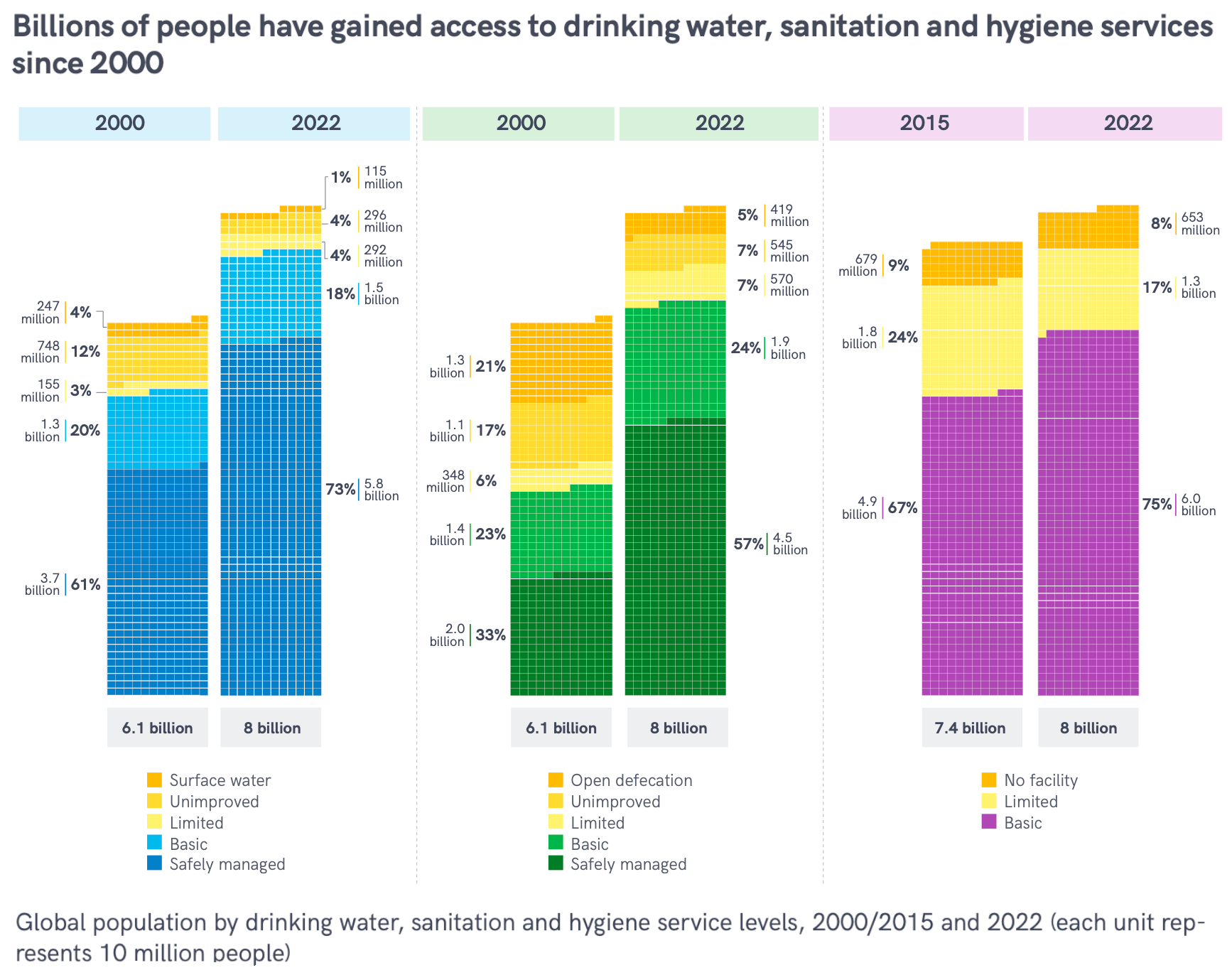
36. Many countries passed laws protecting women
Uzbekistan passed a law giving women greater legal protection against gender-based violence, the Netherlands and Switzerland amended their laws to introduce a consent-based definition of rape, Sierra Leone passed landmark legislation advancing women’s rights, Oman passed a law prohibiting the termination of employment due to pregnancy, childbirth or breastfeeding, Latvia ratified the Istanbul Convention, the international treaty for preventing and combating violence against women and girls, Argentina approved a law designed to prevent gender-based violence online, and in China, a new law protecting women against discrimination and sexual harassment came into effect, the country's most significant reform to women's rights in 30 years.
37. Menstrual and reproductive rights advanced
Mexico's Supreme Court decriminalised abortion nationwide, France amended its constitution to include the words, "no woman may be deprived of the right to termination of pregnancy," Argentina removed the requirement for a prescription to obtain emergency contraception, Honduras ended its ban on the morning after pill, British Columbia made prescription contraception free to all residents, Ghana included free long-term contraception in its national health insurance program, Taiwan made period products available in all schools and the Catalonia region of Spain started providing period products for free at pharmacies.
38. Reproductive rights activists fought back in America
Wisconsin, Minnesota, Nebraska, Virginia and Ohio protected reproductive rights, and the FDA approved the first oral contraceptive for over-the-counter use, as well as the first oral medication designed to treat severe postpartum depression. One of our favourite stories of the year came in June, when, after more than a decade of advocacy, the Pregnant Workers Fairness Act came into effect, changing the health and economic trajectory for at least nine million women and their families, "one of the most significant civil rights victories our country has seen in decades."

39. More girls got a chance at childhood
India, home to the highest number of teenage brides, reported that the proportion of all girls married before the age of 18 has fallen from 46% to 23% in the last 15 years, and off the back of last year's landmark ban on child marriage, the Phillipines reported that teenage pregnancy has fallen from 8.6% to 5.4% in the last five years (good news for a country with one of the highest rates of teen pregnancy in the world). New legislation banning child marriage came into force in England and Wales, and Japan raised the age of consent to 16 and introduced far stricter laws against sex crimes.
40. Lots of other bright spots for education
Punjab, home to over half of Pakistan's population, reported that in the last two decades 13 million girls gained access to education, Nepal reported the number of out of school children fell by 6.7% in the last five years, and in Ethiopia access to pre-primary education has increased from 5.3% to 44%. In both the DRC and Sierra Leone, one fifth of the national budget is now dedicated to education, and this year South Sudan made secondary education free, following the recent leads of Ghana, Madagascar, Malawi, Sierra Leone, Togo, and Zambia. Since 2017, government spending on education in low-income countries as a percentage of GDP has risen from 3.2% to 3.6%.
41. Some good news for LGBTQ rights
Estonia became the 35th country to legalize same-sex marriage, Thailand’s Cabinet approved an amendment to its civil code to allow same-sex marriage, a Peruvian high court ordered same-sex unions to be legally registered, the European Court of Human Rights ruled that Romania and Bulgaria were required to protect the rights of same-sex couples to family life, Taiwan granted full adoption rights to same sex couples, a court in South Korea ruled that denying benefits to same-sex couples was discriminatory, and Hong Kong's top court ordered the government to legally recognise same-sex relationships. Perhaps the biggest news of the year however, was December's announcement by Pope Francis that priests are allowed to bless unmarried and same-sex couples, described as “the most concrete pastoral shift on the stance toward gay couples in the Catholic Church’s 2,000 year history.”

42. Tolerance became legally enshrined in many countries
Mauritius and the Cook Islands decriminalized homosexuality, Sri Lanka’s government gave the green light to a bill looking to do the same, Japan passed a law to promote understanding of LGBTQ citizens, Iceland banned conversion therapy, Finland passed legislation making it substantially easier for transgender people to change their legal gender, Germany's government approved plans to do the same, and Spain passed legislation expanding both reproductive and transgender rights.
43. Access to electricity increased
The number of people without electricity is expected to decrease to 745 million this year. This represents a welcome turnaround from 2022, when the number of people increased for the first time in decades (another pandemic shock). In sub-Saharan Africa, the number of people without access is on track to stabilise in 2023 after rising for three consecutive years, thanks to the tens of millions of people who have recently gained access in southern and eastern Africa.
44. The United States pulled off an economic miracle
In 2022 economists predicted with 100% certainty that the US was going to enter a recession within a year. It didn't happen. GDP growth is now the fastest of all advanced economies, 14 million jobs have been created under the current administration, unemployment is at its lowest since WW2, and new business formation rates are at record highs. Inflation is almost back down to pre-pandemic levels, wages are above pre-pandemic levels (accounting for inflation), and more than a third of the rise in economic inequality between 1979 and 2019 has been reversed. Average wealth has climbed by over $50,000 per household since 2020, and doubled for Americans aged 18-34, home ownership for GenZ is higher than it was for Millennials and GenX at this point in their lives, and the annual deficit is trillions of dollars lower than it was in 2020.
Everyone's still pissed off though.
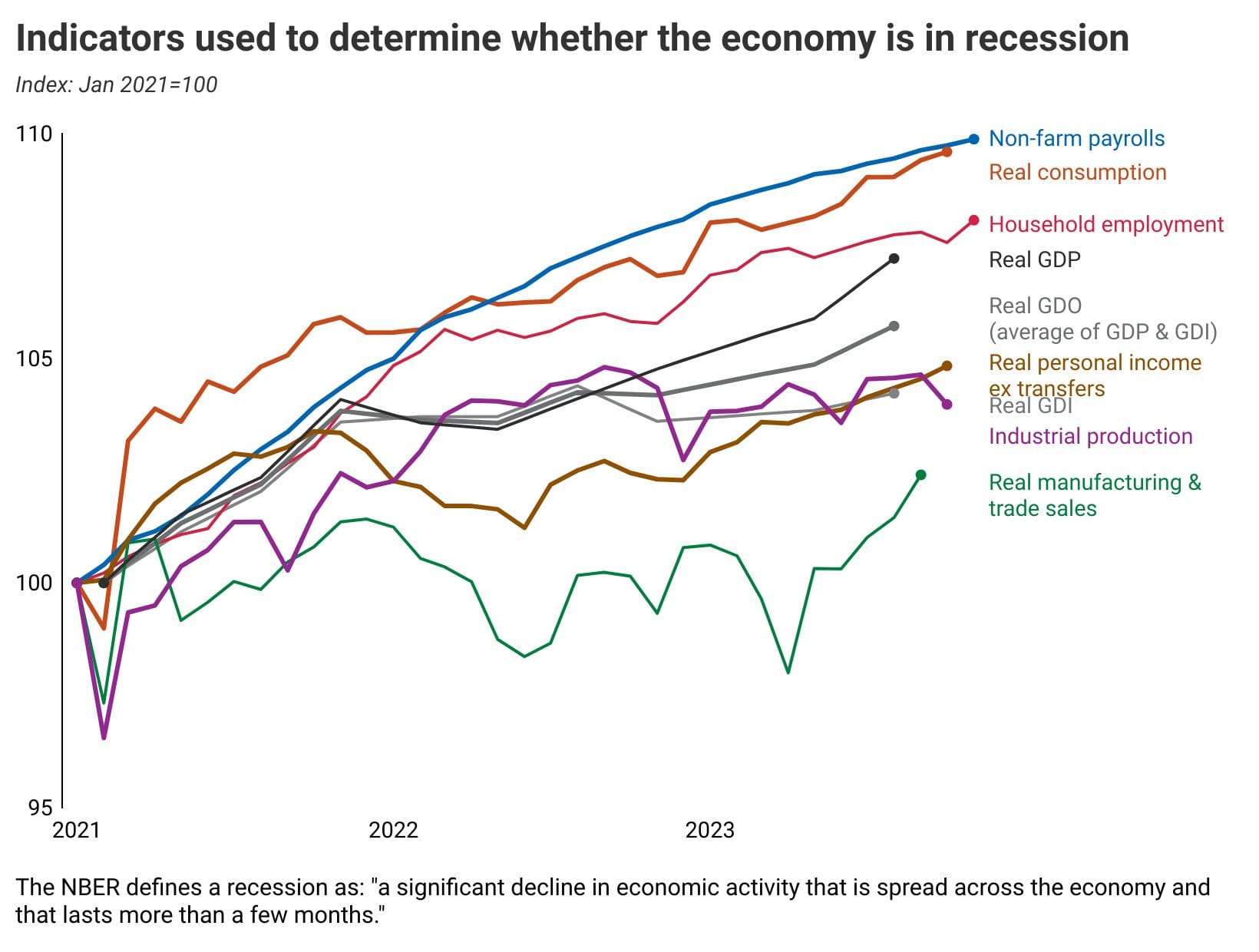
45. A decline in childhood stunting
Stunting is when a child does not have sufficient nutrition to grow and develop. This year Indonesia, Peru, Senegal, Thailand, Kenya, Uganda, Brazil, Cambodia and Ghana all reported multi-year declines, and in May, UNICEF said that since 2000, stunting has declined by one-third, resulting in 60 million fewer undernourished children. In 2022, 182 million children under five were reached with services for the early prevention, detection and treatment of child wasting, up from 154 million the year before.
46. Other, uncelebrated human rights victories
Malaysia and Ghana banned the death penalty, Mexico implemented a National Civil and Family Procedure Code, empowering older persons and people with disabilities to make decisions by themselves, Peru passed a law cancelling unjust fines accrued by Venezuelan refugees who had overstayed their visas, Nigeria became the 13th African state to ratify the the Protocol to the African Charter on the Rights of Older Persons, and Bangladesh reported that its clothing industry has been completely transformed thanks to labour laws passed after the Rana Plaza tragedy ten years ago.
47. Most places in the world are safer than they used to be
The World Bank released its latest data on the global homicide rate. Over the past twenty years, the global homicide rate has decreased by 17%, from 6.99 per 100,000 people in 2001 to 5.79 per 100,000 in 2021, the most recent year with global statistics. Over this time period murders in Africa have decreased by 7%, in North and South America by 8%, in Asia by 29% and in Europe, by an astonishing 72%.
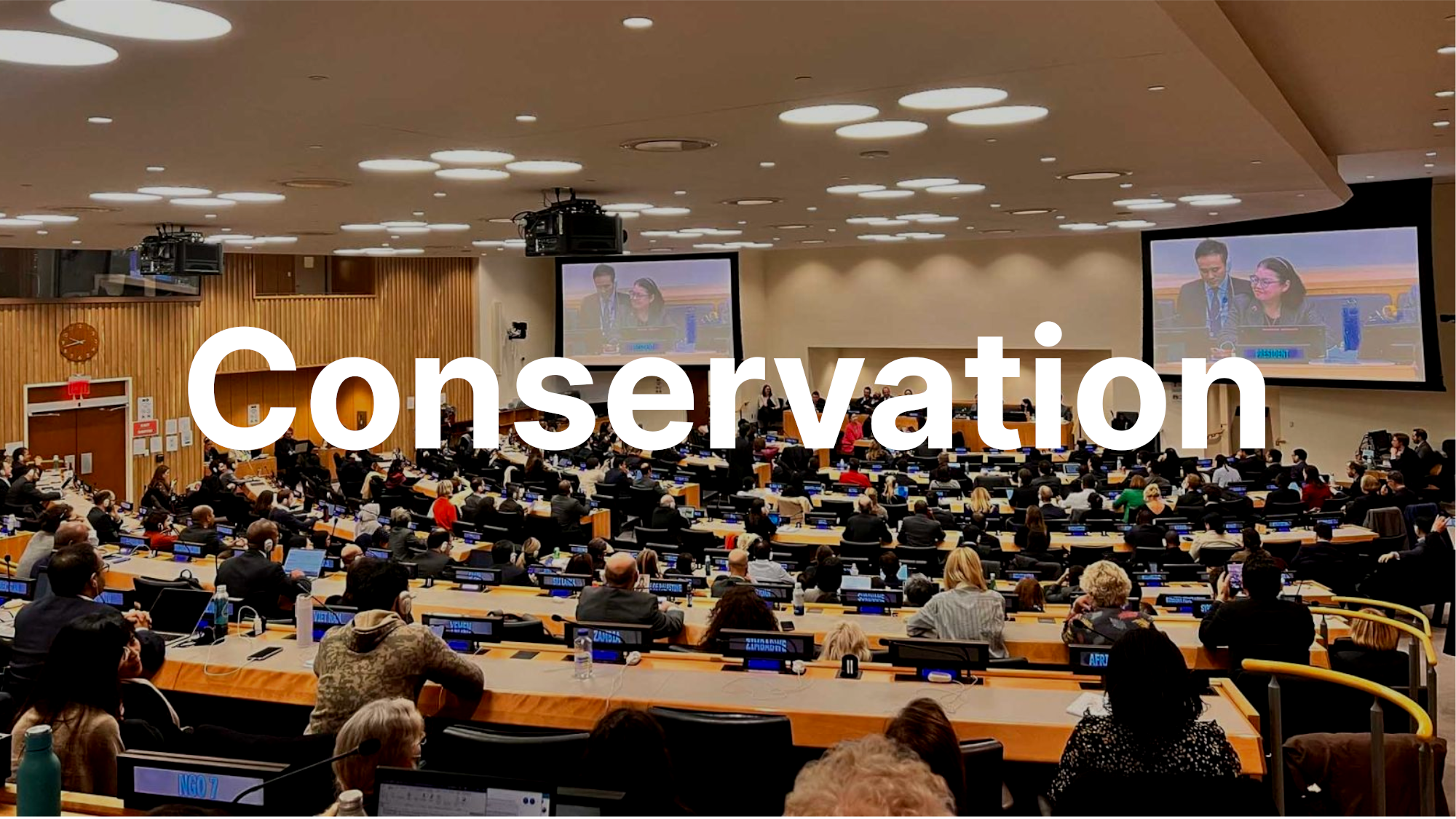
48. The greatest conservation victory of all time
In March this year, 193 countries reached a landmark deal to protect the world's oceans, in what Greenpeace called "the greatest conservation victory of all time." The UN High Seas Treaty is the first international agreement on ocean protection since 1982, providing for the common governance of half the Earth’s surface, and paving the way for conservation on the high seas, with the aim of protecting at least 30% of the planet by 2030. Only about 1% of the high seas is currently protected.
49. Another great year for river and lake restoration
The restoration of Wullar Lake in Pakistan brought back thousands of migratory birds, Chilika Lake, the second biggest lake in India, bounced back after two decades of work, in the Netherlands, a project kicked off to restore one of Europe's largest freshwater lakes, in Florida, nearly half of the Kissimmee River has been restored, in Toronto, the Don River has roared back to life half a century after being declared dead, the Mersey River in England was labelled “the best environmental news story in Europe,” Paris continued its $1.5-billion-dollar effort to clean up the Seine, in Washington, the Potomac is almost safe for swimming, and the waters around New York are teeming with life again.
50. One of the largest ever declines in deforestation
In 2023 deforestation across the nine Amazonian countries was 55.8% lower than last year, in a major turnaround for a region that's vital to curbing climate change. Brazil's deforestation rate fell by over 50%, the largest single year decline since records began, and over a million hectares of forest were protected across South America, including the Cuchilla del San Juan Reserve, linking together two of the world’s greatest biodiversity hotspots, and the Camino del Jaguar Reserve, part of a global biodiversity hotspot that extends from Panama to northern Peru.

51. A lot to celebrate for indigenous conservation
Brazil recognized eight indigenous territories, Colombia expanded three, Ecuador voted to stop oil drilling in its enormous Yasuní National Park, and restored the ancestral homelands of Siekopai Nation, in Japan, the Raporo Ainu Nation reclaimed their historical fishing rights, and indigenous communities took ownership of the Tama Wildlife Reserve in Ethiopia. Land legally owned or managed by indigenous communities around the world has increased by 102.9 billion hectares, an area the size of Egypt, since 2015.
52. Debt for nature swaps ramped up
In May, Ecuador announced the biggest debt-for-nature swap ever, a $1.6-billion deal to reduce its debt burden and free up hundreds of millions of dollars to fund marine conservation around the Galápagos, and in August, Gabon wiped $450 million off its national debt by increasing protections of its marine ecosystems, the second African country after the Seychelles to benefit from this kind of scheme.
53. Cities went green
São Paulo is producing 1.5 million seedlings a year to plant in underprivileged areas, New York transformed the Harlem River shoreline from a dumping ground into a bountiful wetland, Medellín's green corridor programs have reduced urban temperatures by 2°C, Lisbon, Milan and Stockholm announced inner city car bans, London expanded its low emissions zones across the entire city, a ring of former train tracks around Paris was transformed into a semi-wild oasis, a six-lane highway in Madrid was transformed into a riverside park, a former railway line Singapore was converted into a green corridor, and San Francisco now has 48 major circular water systems in operation.

54. Europe passed new laws to protect the environment
In January, the continent's regulators put an end to the use of exceptions for bee-killing pesticides, in May, they implemented a new rule to stop the import of any products that destroy forests, in July, the EU passed the Nature Restoration Act, the first major piece of legislation to protect biodiversity in 30 years, and in November became the first international body to criminalise wide-scale environmental damage “comparable to ecocide." Not bad for a year's work.
55. The United States wasn't too far behind
Major conservation measures were passed in four states including Texas, where voters supported a $1 billion fund for state parks, New York became the first state to pass a law reining in bee-killing pesticides, and California became the first state to ban four food additives. The EPA set new legal limits for drinking water to remove forever chemicals, proposed tougher standards on lead in paint, protected waterways from harmful vessel discharges, and reinstated limits on toxic chemicals from coal-fired power plants. The federal government prohibited all drilling in the Arctic National Wildlife Refuge, started a $1.5 billion urban tree-planting program, pledged $106 million for salmon recovery programs, $161 million for ecosystem restoration on public lands, and created a New Deal-style Climate Corps, signing up over 40,000 people in its first few weeks.
56. A banner year for ocean protection
Over a million square kilometres of ocean was protected off the coasts of Panama, Chile, Papua New Guinea, Dominica, the Congo, Kenya, New Caledonia, Ireland, the United Kingdom, and Australia - which tripled the size of its Macquarie Island Marine Park, and closed off an area larger than Germany to fishing and mining. In March, a group of countries committed over $20 billion of funding to ocean conservation, and in August, a coalition of over a dozen countries spearheaded by Chile, France and Costa Rica tried to officially debate the possibility of an outright ban on deep-sea mining.

57. Some big wins for animal rights
The United States removed the requirement that pharmaceutical companies use animals to test new drugs before human trials, Canada announced a phaseout in chemical toxicity testing, Bhutan became the first country to completely sterilise and vaccinate its entire stray dog population, the number of no-kill dog shelters in the United States reached 57%, up from 24% in 2016, South Korea announced a ban on dog meat by 2027, New Zealand banned live animal exports, Wales banned snares and glue traps, Scotland conducted its last fox hunt, and Lithuania became the 14th European country to ban fur farming.
58. Island restoration showed what's possible
Conservationists in Antigua and Barbados transformed the isle of Redonda from desolate rock to a wildlife haven, a 20-year effort to rid Lehua Island in Hawaii of rats was successfully concluded, seabirds are thriving on Lundy Island off the coast of England after rodent eradication, San Clemente off the coast of California celebrated the de-listing of one bird and four plant species, in New Zealand, the Mercury Islands achieved predator-free status, and Floreana Island in the Galapagos, the first island to be colonized in 1832, kicked off "one of the greatest conservation interventions of all time."
59. A lot of new areas were protected
China protected the entire Tibetan plateau, an area larger than all of Western Europe, Mexico announced 13 new conservation areas, Romania proposed a 101,000-hectare park as a 'Yellowstone for Europe,' South Africa announced a plan to extend nine nature reserves and create six new ones in the Western Cape, Zimbabwe and Zambia agreed to protect 18,515 km2 of the lower Zambezi-Mana River basin as a transboundary conservation area, and the United States reinstated protections for Alaska’s Tongass National Forest, and created a 1,638 km2 national monument in southern Nevada and a 4,045 km2 national monument in northern Arizona.
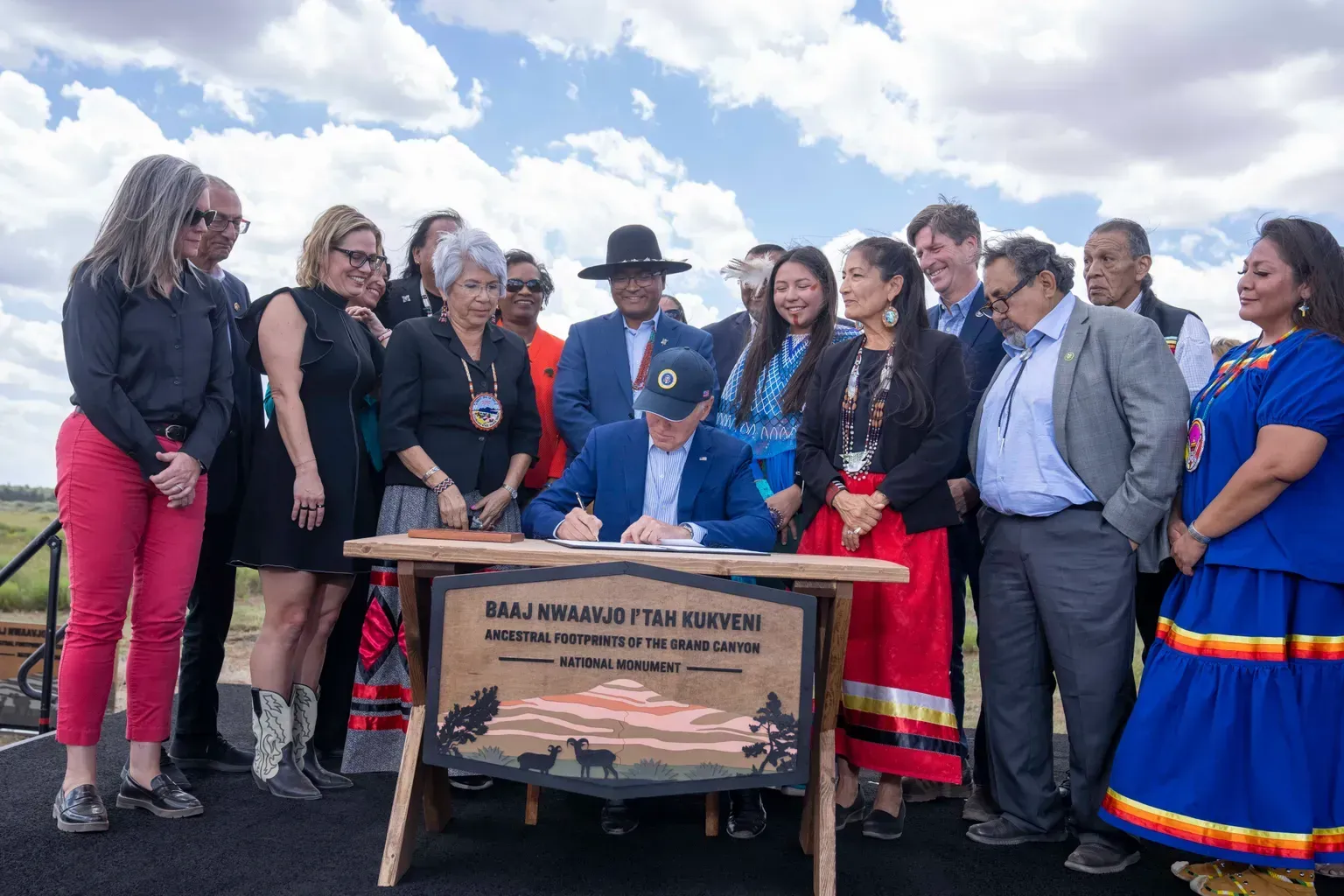
60. Tree planting and reforestation efforts continued
Indonesia said it would restore close to half a million acres of palm oil plantations, Kenya celebrated its first national tree planting holiday, Algeria started a project to reforest a million hectares, 6,000 acres were re-greened in West Bengal, India, Mali kicked off a program to reforest 400,000 hectares, Fiji said it has planted over 18 million trees since 2019, and Malawi said it has restored about 1.7 million hectares since 2015. Also, in July a new report showed that small-scale restoration efforts across Africa have contributed to the greening of around 400,000 km2, an area the size of Zimbabwe.
61. There's less plastic than we think in the sea
In August, Dutch researchers released a report that looked at over 20,000 measurements worldwide, and found the extent of plastic soup in the world's oceans is closer to 3.2 million tons, far smaller than the commonly accepted estimates of 50-300 million tons. The following month, Japanese scientists discovered a plastic-eating bacteria that could help solve global waste, and the EU announced further plans to crack down on microplastics with the aim of cutting plastic pellet pollution by 74% by the end of the decade.
62. First Nations in North America notched up some big wins
In California, the Klamath Tribes officially kicked off the world's largest dam removal project, 12,500 hectares were restored to the Penobscot Nation in Maine, First Nations in Minnesota gained greater management rights over three million acres, a $1 billion 'nature agreement' in British Columbia transformed conservation practices in collaboration with First Nations, bison restoration efforts began in Montana, South Dakota and Alberta, and the Ḵwiḵwa̱sut'inux̱w Ha̱xwa’mis Nation designated a new 40,000-hectare protected area north of Vancouver Island.
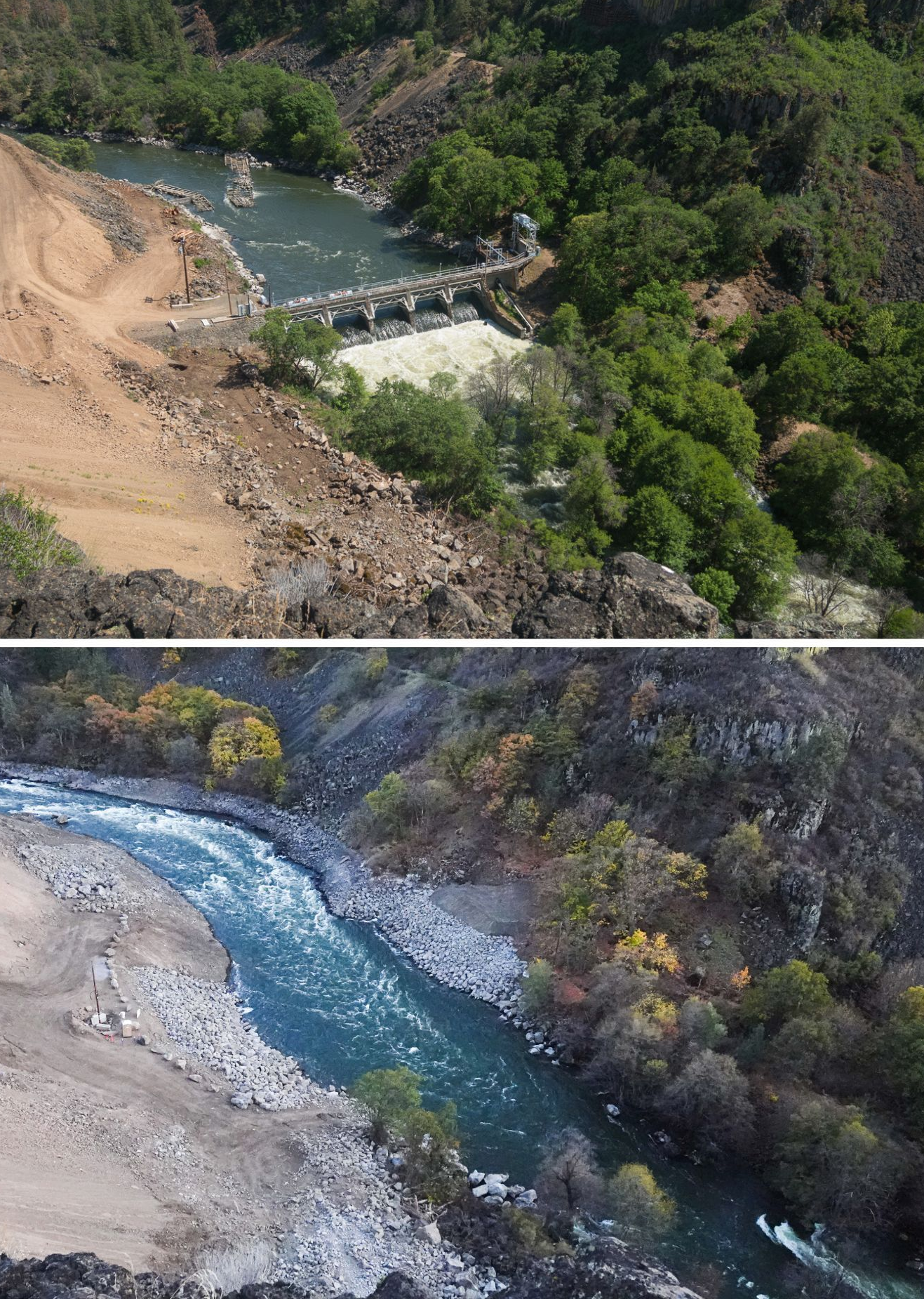
63. Some bright spots on mangroves
Mangroves are in trouble around the world, but not everywhere. China's area of mangroves has actually increased in the last two decades, Indonesia is running a program to restore 600,000 hectares by 2024, Oman has planted more than 3.5 million mangrove seeds as part of its Blue Carbon project, Abu Dhabi has planted 20 million seeds and increased mangrove cover by 6,400 hectares, in Pakistan, a massive mangrove restoration project is underway, and in Baja California Sur, Mexico, a community has planted 1.2 million seedlings, transforming vast stretches of barren sand to green.
64. The largest ever commitment to water conservation
In March, 10,000 participants at the UN Water Conference pledged billions of dollars and made over 700 commitments to ensure a water secure future. The biggest commitment of all was the Freshwater Challenge, an incredibly ambitious project to restore the world's waterways. Driven by Colombia, the DRC, Ecuador, Gabon, Mexico and Zambia, the project aims to restore 300,000 kilometres of rivers and 350 million hectares of wetlands (an area larger than India) by 2030.
65. Over 100 countries now have plastic bans
This year, New Zealand became the first country to ban plastic bags for loose fruit and vegetables, England banned plastic cutlery, balloon sticks and polystyrene cups, Jamaica said that its three year old plastic ban has largely eliminated plastic straws and bags and styrofoam boxes and cups, the United States announced a phaseout of single-use plastics across all its public lands, and the UAE said it would ban single-use plastic shopping bags starting in January 2024. “It’s really, really encouraging to see those numbers trending down."
66. Endangered species that are recovering
African lion / African elephant / American alligator / American bison / Asiatic lion / Atlantic puffin / Azores bullfinch / Bald eagle / Bali myna / Black rhino / Black-footed ferret / Black-veined moth / Blue whale / Bornean orangutan / Chinese sturgeon / Darwin’s flycatcher / East Pacific green sea turtle / Eastern barred bandicoot / Eurasian brown bear / Eurasian beaver / Eurasian wolf / Fender’s blue butterfly / Galapagos giant tortoise / Golden eagle / Golden lion tamarin / Greater bilby / Hargila stork / Humpback whale / Iberian lynx / Jaguar / Kaempfer’s woodpecker / Kipunji monkey / Large heath butterfly / Mexican wolf / Monarch butterfly / Mountain gorilla / Olive ridley sea turtle / Peregrine falcon / Polynesian tree snail / Red squirrel / Saiga antelope / Saimaa ringed seal / Sea otter / Siamese crocodile / Snow leopard / Sooty albatross / Southern right whale / Stocky galaxias fish / Takahē / Three-banded armadillo / Tibetan antelope / Tibetan red deer / Tibetan white-lipped deer / Tiger / White rhino / Wood stork / Whooper swans / Yunnan golden hair monkey / Zebra shark.

